| Listing 1 - 10 of 28 | << page >> |
Sort by
|
Book
ISBN: 0691223807 Year: 1988 Publisher: Princeton, New Jersey : Princeton University Press,
Abstract | Keywords | Export | Availability | Bookmark
 Loading...
Loading...Choose an application
- Reference Manager
- EndNote
- RefWorks (Direct export to RefWorks)
This book starts with the elementary theory of Lie groups of matrices and arrives at the definition, elementary properties, and first applications of cohomological induction, which is a recently discovered algebraic construction of group representations. Along the way it develops the computational techniques that are so important in handling Lie groups. The book is based on a one-semester course given at the State University of New York, Stony Brook in fall, 1986 to an audience having little or no background in Lie groups but interested in seeing connections among algebra, geometry, and Lie theory. These notes develop what is needed beyond a first graduate course in algebra in order to appreciate cohomological induction and to see its first consequences. Along the way one is able to study homological algebra with a significant application in mind; consequently one sees just what results in that subject are fundamental and what results are minor.
Lie groups. --- Algebra. --- Analytic group. --- Approximate identity. --- Associative algebra. --- Associativity formulas. --- Borel subalgebra. --- Borel-Weil Theorem. --- Boundary operator. --- Cartan subgroup. --- Chain map. --- Change of rings. --- Closed linear group. --- Cohomological induction. --- Complexification. --- Convolution. --- Derivation. --- Derived functor. --- Diffeomorphism. --- Divisible group. --- Dual vector space. --- Enough injectives. --- Equivalence. --- Euler-Poincare principle. --- Exponential. --- Forgetful functor. --- Free resolution. --- Functor. --- Good category. --- Haar measure. --- Highest weight. --- Homogeneous polynomial. --- Homogeneous tensor. --- I functor. --- Induction, cohomological. --- Inner derivation. --- Isotypic subspace. --- K-isotypic subspace. --- Left exact functor. --- Lie algebra. --- Lie bracket. --- Linear extension. --- Long exact sequence. --- Mackey isomorphism. --- Matrix coefficient. --- Multiplicity. --- Normalized Haar measure. --- Positive root. --- Quotient representation. --- Reductive group. --- Regular representation. --- Right exact functor. --- Schur orthogonality. --- Semidirect product. --- Spectral sequence.
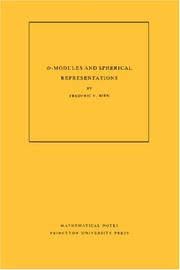
ISBN: 1400862078 9781400862078 0691025177 9780691608327 9780691025179 0691025177 0691608326 9780691608327 Year: 1990 Publisher: Princeton, New Jersey
Abstract | Keywords | Export | Availability | Bookmark
 Loading...
Loading...Choose an application
- Reference Manager
- EndNote
- RefWorks (Direct export to RefWorks)
The theory of D-modules deals with the algebraic aspects of differential equations. These are particularly interesting on homogeneous manifolds, since the infinitesimal action of a Lie algebra consists of differential operators. Hence, it is possible to attach geometric invariants, like the support and the characteristic variety, to representations of Lie groups. By considering D-modules on flag varieties, one obtains a simple classification of all irreducible admissible representations of reductive Lie groups. On the other hand, it is natural to study the representations realized by functions on pseudo-Riemannian symmetric spaces, i.e., spherical representations. The problem is then to describe the spherical representations among all irreducible ones, and to compute their multiplicities. This is the goal of this work, achieved fairly completely at least for the discrete series representations of reductive symmetric spaces. The book provides a general introduction to the theory of D-modules on flag varieties, and it describes spherical D-modules in terms of a cohomological formula. Using microlocalization of representations, the author derives a criterion for irreducibility. The relation between multiplicities and singularities is also discussed at length.Originally published in 1990.The Princeton Legacy Library uses the latest print-on-demand technology to again make available previously out-of-print books from the distinguished backlist of Princeton University Press. These editions preserve the original texts of these important books while presenting them in durable paperback and hardcover editions. The goal of the Princeton Legacy Library is to vastly increase access to the rich scholarly heritage found in the thousands of books published by Princeton University Press since its founding in 1905.
Differentiable manifolds. --- D-modules. --- Representations of groups. --- Lie groups. --- Groups, Lie --- Lie algebras --- Symmetric spaces --- Topological groups --- Group representation (Mathematics) --- Groups, Representation theory of --- Group theory --- Modules (Algebra) --- Differential manifolds --- Manifolds (Mathematics) --- Affine space. --- Algebraic cycle. --- Algebraic element. --- Analytic function. --- Annihilator (ring theory). --- Automorphism. --- Banach space. --- Base change. --- Big O notation. --- Bijection. --- Bilinear form. --- Borel subgroup. --- Cartan subalgebra. --- Cofibration. --- Cohomology. --- Commutative diagram. --- Commutative property. --- Commutator subgroup. --- Complexification (Lie group). --- Conjugacy class. --- Coproduct. --- Coset. --- Cotangent space. --- D-module. --- Derived category. --- Diagram (category theory). --- Differential operator. --- Dimension (vector space). --- Direct image functor. --- Discrete series representation. --- Disk (mathematics). --- Dot product. --- Double coset. --- Eigenfunction. --- Eigenvalues and eigenvectors. --- Endomorphism. --- Euler operator. --- Existential quantification. --- Fibration. --- Function space. --- Functor. --- G-module. --- Gelfand pair. --- Generic point. --- Hilbert space. --- Holomorphic function. --- Homomorphism. --- Hyperfunction. --- Ideal (ring theory). --- Infinitesimal character. --- Inner automorphism. --- Invertible sheaf. --- Irreducibility (mathematics). --- Irreducible representation. --- Levi decomposition. --- Lie algebra. --- Line bundle. --- Linear algebraic group. --- Linear space (geometry). --- Manifold. --- Maximal compact subgroup. --- Maximal torus. --- Metric space. --- Module (mathematics). --- Moment map. --- Morphism. --- Noetherian ring. --- Open set. --- Presheaf (category theory). --- Principal series representation. --- Projective line. --- Projective object. --- Projective space. --- Projective variety. --- Reductive group. --- Riemannian geometry. --- Riemann–Hilbert correspondence. --- Right inverse. --- Ring (mathematics). --- Root system. --- Satake diagram. --- Sheaf (mathematics). --- Sheaf of modules. --- Special case. --- Sphere. --- Square-integrable function. --- Sub"ient. --- Subalgebra. --- Subcategory. --- Subgroup. --- Summation. --- Surjective function. --- Symmetric space. --- Symplectic geometry. --- Tensor product. --- Theorem. --- Triangular matrix. --- Vector bundle. --- Volume form. --- Weyl group.
Book
ISBN: 1282458000 1282936328 9786612936326 9786612458002 1400835399 9781400835393 9780691142920 0691142920 0691142939 9780691142937 Year: 2010 Publisher: Princeton Princeton University Press
Abstract | Keywords | Export | Availability | Bookmark
 Loading...
Loading...Choose an application
- Reference Manager
- EndNote
- RefWorks (Direct export to RefWorks)
This book studies the intersection cohomology of the Shimura varieties associated to unitary groups of any rank over Q. In general, these varieties are not compact. The intersection cohomology of the Shimura variety associated to a reductive group G carries commuting actions of the absolute Galois group of the reflex field and of the group G(Af) of finite adelic points of G. The second action can be studied on the set of complex points of the Shimura variety. In this book, Sophie Morel identifies the Galois action--at good places--on the G(Af)-isotypical components of the cohomology. Morel uses the method developed by Langlands, Ihara, and Kottwitz, which is to compare the Grothendieck-Lefschetz fixed point formula and the Arthur-Selberg trace formula. The first problem, that of applying the fixed point formula to the intersection cohomology, is geometric in nature and is the object of the first chapter, which builds on Morel's previous work. She then turns to the group-theoretical problem of comparing these results with the trace formula, when G is a unitary group over Q. Applications are then given. In particular, the Galois representation on a G(Af)-isotypical component of the cohomology is identified at almost all places, modulo a non-explicit multiplicity. Morel also gives some results on base change from unitary groups to general linear groups.
Shimura varieties. --- Homology theory. --- Cohomology theory --- Contrahomology theory --- Algebraic topology --- Varieties, Shimura --- Arithmetical algebraic geometry --- Accuracy and precision. --- Adjoint. --- Algebraic closure. --- Archimedean property. --- Automorphism. --- Base change map. --- Base change. --- Calculation. --- Clay Mathematics Institute. --- Coefficient. --- Compact element. --- Compact space. --- Comparison theorem. --- Conjecture. --- Connected space. --- Connectedness. --- Constant term. --- Corollary. --- Duality (mathematics). --- Existential quantification. --- Exterior algebra. --- Finite field. --- Finite set. --- Fundamental lemma (Langlands program). --- Galois group. --- General linear group. --- Haar measure. --- Hecke algebra. --- Homomorphism. --- L-function. --- Logarithm. --- Mathematical induction. --- Mathematician. --- Maximal compact subgroup. --- Maximal ideal. --- Morphism. --- Neighbourhood (mathematics). --- Open set. --- Parabolic induction. --- Permutation. --- Prime number. --- Ramanujan–Petersson conjecture. --- Reductive group. --- Ring (mathematics). --- Scientific notation. --- Shimura variety. --- Simply connected space. --- Special case. --- Sub"ient. --- Subalgebra. --- Subgroup. --- Symplectic group. --- Theorem. --- Trace formula. --- Unitary group. --- Weyl group.
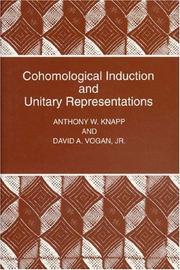
ISBN: 0691037566 1400883938 Year: 1995 Publisher: Princeton (N.J.): Princeton university press
Abstract | Keywords | Export | Availability | Bookmark
 Loading...
Loading...Choose an application
- Reference Manager
- EndNote
- RefWorks (Direct export to RefWorks)
This book offers a systematic treatment--the first in book form--of the development and use of cohomological induction to construct unitary representations. George Mackey introduced induction in 1950 as a real analysis construction for passing from a unitary representation of a closed subgroup of a locally compact group to a unitary representation of the whole group. Later a parallel construction using complex analysis and its associated co-homology theories grew up as a result of work by Borel, Weil, Harish-Chandra, Bott, Langlands, Kostant, and Schmid. Cohomological induction, introduced by Zuckerman, is an algebraic analog that is technically more manageable than the complex-analysis construction and leads to a large repertory of irreducible unitary representations of reductive Lie groups. The book, which is accessible to students beyond the first year of graduate school, will interest mathematicians and physicists who want to learn about and take advantage of the algebraic side of the representation theory of Lie groups. Cohomological Induction and Unitary Representations develops the necessary background in representation theory and includes an introductory chapter of motivation, a thorough treatment of the "translation principle," and four appendices on algebra and analysis.
512.73 --- Harmonic analysis --- Homology theory --- Representations of groups --- Semisimple Lie groups --- Semi-simple Lie groups --- Lie groups --- Group representation (Mathematics) --- Groups, Representation theory of --- Group theory --- Cohomology theory --- Contrahomology theory --- Algebraic topology --- Analysis (Mathematics) --- Functions, Potential --- Potential functions --- Banach algebras --- Calculus --- Mathematical analysis --- Mathematics --- Bessel functions --- Fourier series --- Harmonic functions --- Time-series analysis --- Cohomology theory of algebraic varieties and schemes --- 512.73 Cohomology theory of algebraic varieties and schemes --- Lie algebras. --- Lie, Algèbres de. --- Semisimple Lie groups. --- Representations of groups. --- Homology theory. --- Harmonic analysis. --- Représentations d'algèbres de Lie --- Representations of Lie algebras --- Abelian category. --- Additive identity. --- Adjoint representation. --- Algebra homomorphism. --- Associative algebra. --- Associative property. --- Automorphic form. --- Automorphism. --- Banach space. --- Basis (linear algebra). --- Bilinear form. --- Cartan pair. --- Cartan subalgebra. --- Cartan subgroup. --- Cayley transform. --- Character theory. --- Classification theorem. --- Cohomology. --- Commutative property. --- Complexification (Lie group). --- Composition series. --- Conjugacy class. --- Conjugate transpose. --- Diagram (category theory). --- Dimension (vector space). --- Dirac delta function. --- Discrete series representation. --- Dolbeault cohomology. --- Eigenvalues and eigenvectors. --- Explicit formulae (L-function). --- Fubini's theorem. --- Functor. --- Gregg Zuckerman. --- Grothendieck group. --- Grothendieck spectral sequence. --- Haar measure. --- Hecke algebra. --- Hermite polynomials. --- Hermitian matrix. --- Hilbert space. --- Hilbert's basis theorem. --- Holomorphic function. --- Hopf algebra. --- Identity component. --- Induced representation. --- Infinitesimal character. --- Inner product space. --- Invariant subspace. --- Invariant theory. --- Inverse limit. --- Irreducible representation. --- Isomorphism class. --- Langlands classification. --- Langlands decomposition. --- Lexicographical order. --- Lie algebra. --- Linear extension. --- Linear independence. --- Mathematical induction. --- Matrix group. --- Module (mathematics). --- Monomial. --- Noetherian. --- Orthogonal transformation. --- Parabolic induction. --- Penrose transform. --- Projection (linear algebra). --- Reductive group. --- Representation theory. --- Semidirect product. --- Semisimple Lie algebra. --- Sesquilinear form. --- Sheaf cohomology. --- Skew-symmetric matrix. --- Special case. --- Spectral sequence. --- Stein manifold. --- Sub"ient. --- Subalgebra. --- Subcategory. --- Subgroup. --- Submanifold. --- Summation. --- Symmetric algebra. --- Symmetric space. --- Symmetrization. --- Tensor product. --- Theorem. --- Uniqueness theorem. --- Unitary group. --- Unitary operator. --- Unitary representation. --- Upper and lower bounds. --- Verma module. --- Weight (representation theory). --- Weyl character formula. --- Weyl group. --- Weyl's theorem. --- Zorn's lemma. --- Zuckerman functor.
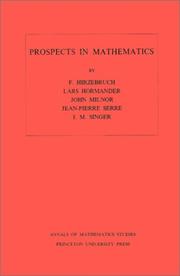
ISBN: 0691080941 9780691080949 1400881692 Year: 1971 Volume: 70 Publisher: Princeton : Princeton University Press,
Abstract | Keywords | Export | Availability | Bookmark
 Loading...
Loading...Choose an application
- Reference Manager
- EndNote
- RefWorks (Direct export to RefWorks)
Five papers by distinguished American and European mathematicians describe some current trends in mathematics in the perspective of the recent past and in terms of expectations for the future. Among the subjects discussed are algebraic groups, quadratic forms, topological aspects of global analysis, variants of the index theorem, and partial differential equations.
Mathematics --- Mathématiques --- Congresses --- Congrès --- 51 --- -Math --- Science --- Congresses. --- -Mathematics --- 51 Mathematics --- -51 Mathematics --- Math --- Mathématiques --- Congrès --- A priori estimate. --- Addition. --- Additive group. --- Affine space. --- Algebraic geometry. --- Algebraic group. --- Atiyah–Singer index theorem. --- Bernoulli number. --- Boundary value problem. --- Bounded operator. --- C*-algebra. --- Canonical transformation. --- Cauchy problem. --- Characteristic class. --- Clifford algebra. --- Coefficient. --- Cohomology. --- Commutative property. --- Commutative ring. --- Complex manifold. --- Complex number. --- Complex vector bundle. --- Dedekind sum. --- Degenerate bilinear form. --- Diagram (category theory). --- Diffeomorphism. --- Differentiable manifold. --- Differential operator. --- Dimension (vector space). --- Ellipse. --- Elliptic operator. --- Equation. --- Euler characteristic. --- Euler number. --- Existence theorem. --- Exotic sphere. --- Finite difference. --- Finite group. --- Fourier integral operator. --- Fourier transform. --- Fourier. --- Fredholm operator. --- Hardy space. --- Hilbert space. --- Holomorphic vector bundle. --- Homogeneous coordinates. --- Homomorphism. --- Homotopy. --- Hyperbolic partial differential equation. --- Identity component. --- Integer. --- Integral transform. --- Isomorphism class. --- John Milnor. --- K-theory. --- Lebesgue measure. --- Line bundle. --- Local ring. --- Mathematics. --- Maximal ideal. --- Modular form. --- Module (mathematics). --- Monoid. --- Normal bundle. --- Number theory. --- Open set. --- Parametrix. --- Parity (mathematics). --- Partial differential equation. --- Piecewise linear manifold. --- Poisson bracket. --- Polynomial ring. --- Polynomial. --- Prime number. --- Principal part. --- Projective space. --- Pseudo-differential operator. --- Quadratic form. --- Rational variety. --- Real number. --- Reciprocity law. --- Resolution of singularities. --- Riemann–Roch theorem. --- Shift operator. --- Simply connected space. --- Special case. --- Square-integrable function. --- Subalgebra. --- Submanifold. --- Support (mathematics). --- Surjective function. --- Symmetric bilinear form. --- Symplectic vector space. --- Tangent space. --- Theorem. --- Topology. --- Variable (mathematics). --- Vector bundle. --- Vector space. --- Winding number. --- Mathematics - Congresses
Book
ISBN: 0691080291 1322884943 069164554X 1400869293 9781400869299 9780691618548 0691618542 Year: 1970 Publisher: Princeton : Princeton University Press,
Abstract | Keywords | Export | Availability | Bookmark
 Loading...
Loading...Choose an application
- Reference Manager
- EndNote
- RefWorks (Direct export to RefWorks)
This book is a sequel to Lectures on Complex Analytic Varieties: The Local Paranwtrization Theorem (Mathematical Notes 10, 1970). Its unifying theme is the study of local properties of finite analytic mappings between complex analytic varieties; these mappings are those in several dimensions that most closely resemble general complex analytic mappings in one complex dimension. The purpose of this volume is rather to clarify some algebraic aspects of the local study of complex analytic varieties than merely to examine finite analytic mappings for their own sake.Originally published in 1970.The Princeton Legacy Library uses the latest print-on-demand technology to again make available previously out-of-print books from the distinguished backlist of Princeton University Press. These editions preserve the original texts of these important books while presenting them in durable paperback and hardcover editions. The goal of the Princeton Legacy Library is to vastly increase access to the rich scholarly heritage found in the thousands of books published by Princeton University Press since its founding in 1905.
Complex analysis --- Analytic spaces --- Mathematics --- Physical Sciences & Mathematics --- Calculus --- Spaces, Analytic --- Analytic functions --- Functions of several complex variables --- Algebra homomorphism. --- Algebraic curve. --- Algebraic extension. --- Algebraic surface. --- Algebraic variety. --- Analytic continuation. --- Analytic function. --- Associated prime. --- Atlas (topology). --- Automorphism. --- Bernhard Riemann. --- Big O notation. --- Branch point. --- Change of variables. --- Characterization (mathematics). --- Codimension. --- Coefficient. --- Cohomology. --- Complete intersection. --- Complex analysis. --- Complex conjugate. --- Complex dimension. --- Complex number. --- Connected component (graph theory). --- Corollary. --- Critical point (mathematics). --- Diagram (category theory). --- Dimension (vector space). --- Dimension. --- Disjoint union. --- Divisor. --- Equation. --- Equivalence class. --- Exact sequence. --- Existential quantification. --- Finitely generated module. --- Geometry. --- Hamiltonian mechanics. --- Holomorphic function. --- Homeomorphism. --- Homological dimension. --- Homomorphism. --- Hypersurface. --- Ideal (ring theory). --- Identity element. --- Induced homomorphism. --- Inequality (mathematics). --- Injective function. --- Integral domain. --- Invertible matrix. --- Irreducible component. --- Isolated singularity. --- Isomorphism class. --- Jacobian matrix and determinant. --- Linear map. --- Linear subspace. --- Local ring. --- Mathematical induction. --- Mathematics. --- Maximal element. --- Maximal ideal. --- Meromorphic function. --- Modular arithmetic. --- Module (mathematics). --- Module homomorphism. --- Monic polynomial. --- Monomial. --- Neighbourhood (mathematics). --- Noetherian. --- Open set. --- Parametric equation. --- Parametrization. --- Permutation. --- Polynomial ring. --- Polynomial. --- Power series. --- Quadratic form. --- Quotient module. --- Regular local ring. --- Removable singularity. --- Ring (mathematics). --- Ring homomorphism. --- Row and column vectors. --- Scalar multiplication. --- Scientific notation. --- Several complex variables. --- Sheaf (mathematics). --- Special case. --- Subalgebra. --- Submanifold. --- Subset. --- Summation. --- Surjective function. --- Taylor series. --- Theorem. --- Three-dimensional space (mathematics). --- Topological space. --- Vector space. --- Weierstrass preparation theorem. --- Zero divisor. --- Fonctions de plusieurs variables complexes --- Variétés complexes
Book
ISBN: 069108176X 1322884951 1400869307 0691636443 Year: 1978 Publisher: Princeton : Princeton University Press,
Abstract | Keywords | Export | Availability | Bookmark
 Loading...
Loading...Choose an application
- Reference Manager
- EndNote
- RefWorks (Direct export to RefWorks)
The classical uniformization theorem for Riemann surfaces and its recent extensions can be viewed as introducing special pseudogroup structures, affine or projective structures, on Riemann surfaces. In fact, the additional structures involved can be considered as local forms of the uniformizations of Riemann surfaces. In this study, Robert Gunning discusses the corresponding pseudogroup structures on higher-dimensional complex manifolds, modeled on the theory as developed for Riemann surfaces.Originally published in 1978.The Princeton Legacy Library uses the latest print-on-demand technology to again make available previously out-of-print books from the distinguished backlist of Princeton University Press. These editions preserve the original texts of these important books while presenting them in durable paperback and hardcover editions. The goal of the Princeton Legacy Library is to vastly increase access to the rich scholarly heritage found in the thousands of books published by Princeton University Press since its founding in 1905.
Analytical spaces --- Differential geometry. Global analysis --- Complex manifolds --- Connections (Mathematics) --- Pseudogroups --- Mathematics --- Physical Sciences & Mathematics --- Calculus --- Global analysis (Mathematics) --- Lie groups --- Geometry, Differential --- Analytic spaces --- Manifolds (Mathematics) --- Adjunction formula. --- Affine connection. --- Affine transformation. --- Algebraic surface. --- Algebraic torus. --- Algebraic variety. --- Analytic continuation. --- Analytic function. --- Automorphic function. --- Automorphism. --- Bilinear form. --- Canonical bundle. --- Characterization (mathematics). --- Cohomology. --- Compact Riemann surface. --- Complex Lie group. --- Complex analysis. --- Complex dimension. --- Complex manifold. --- Complex multiplication. --- Complex number. --- Complex plane. --- Complex torus. --- Complex vector bundle. --- Contraction mapping. --- Covariant derivative. --- Differentiable function. --- Differentiable manifold. --- Differential equation. --- Differential form. --- Differential geometry. --- Differential operator. --- Dimension (vector space). --- Dimension. --- Elliptic operator. --- Elliptic surface. --- Enriques surface. --- Equation. --- Existential quantification. --- Explicit formula. --- Explicit formulae (L-function). --- Exterior derivative. --- Fiber bundle. --- General linear group. --- Geometric genus. --- Group homomorphism. --- Hausdorff space. --- Holomorphic function. --- Homomorphism. --- Identity matrix. --- Invariant subspace. --- Invertible matrix. --- Irreducible representation. --- Jacobian matrix and determinant. --- K3 surface. --- Kähler manifold. --- Lie algebra representation. --- Lie algebra. --- Line bundle. --- Linear equation. --- Linear map. --- Linear space (geometry). --- Linear subspace. --- Manifold. --- Mathematical analysis. --- Mathematical induction. --- Ordinary differential equation. --- Partial differential equation. --- Permutation. --- Polynomial. --- Principal bundle. --- Projection (linear algebra). --- Projective connection. --- Projective line. --- Pseudogroup. --- Quadratic transformation. --- Quotient space (topology). --- Representation theory. --- Riemann surface. --- Riemann–Roch theorem. --- Schwarzian derivative. --- Sheaf (mathematics). --- Special case. --- Subalgebra. --- Subgroup. --- Submanifold. --- Symmetric tensor. --- Symmetrization. --- Tangent bundle. --- Tangent space. --- Tensor field. --- Tensor product. --- Tensor. --- Theorem. --- Topological manifold. --- Uniformization theorem. --- Uniformization. --- Unit (ring theory). --- Vector bundle. --- Vector space. --- Fonctions de plusieurs variables complexes --- Variétés complexes
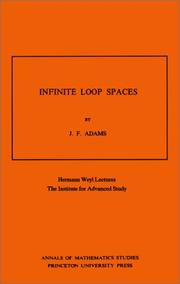
ISBN: 0691082073 0691082065 1400821258 Year: 1978 Volume: no. 90 Publisher: Princeton : Tokyo : Princeton University Press University of Tokyo press,
Abstract | Keywords | Export | Availability | Bookmark
 Loading...
Loading...Choose an application
- Reference Manager
- EndNote
- RefWorks (Direct export to RefWorks)
The theory of infinite loop spaces has been the center of much recent activity in algebraic topology. Frank Adams surveys this extensive work for researchers and students. Among the major topics covered are generalized cohomology theories and spectra; infinite-loop space machines in the sense of Boadman-Vogt, May, and Segal; localization and group completion; the transfer; the Adams conjecture and several proofs of it; and the recent theories of Adams and Priddy and of Madsen, Snaith, and Tornehave.
Algebraic topology --- Loop spaces --- Espaces de lacets --- Infinite loop spaces. --- Abelian group. --- Adams spectral sequence. --- Adjoint functors. --- Algebraic K-theory. --- Algebraic topology. --- Automorphism. --- Axiom. --- Bott periodicity theorem. --- CW complex. --- Calculation. --- Cartesian product. --- Cobordism. --- Coefficient. --- Cofibration. --- Cohomology operation. --- Cohomology ring. --- Cohomology. --- Commutative diagram. --- Continuous function. --- Counterexample. --- De Rham cohomology. --- Diagram (category theory). --- Differentiable manifold. --- Dimension. --- Discrete space. --- Disjoint union. --- Double coset. --- Eilenberg. --- Eilenberg–Steenrod axioms. --- Endomorphism. --- Epimorphism. --- Equivalence class. --- Euler class. --- Existential quantification. --- Explicit formulae (L-function). --- Exterior algebra. --- F-space. --- Fiber bundle. --- Fibration. --- Finite group. --- Function composition. --- Function space. --- Functor. --- Fundamental class. --- Fundamental group. --- Geometry. --- H-space. --- Homology (mathematics). --- Homomorphism. --- Homotopy category. --- Homotopy group. --- Homotopy. --- Hurewicz theorem. --- Inverse limit. --- J-homomorphism. --- K-theory. --- Limit (mathematics). --- Loop space. --- Mathematical induction. --- Maximal torus. --- Module (mathematics). --- Monoid. --- Monoidal category. --- Moore space. --- Morphism. --- Multiplication. --- Natural transformation. --- P-adic number. --- P-complete. --- Parameter space. --- Permutation. --- Prime number. --- Principal bundle. --- Principal ideal domain. --- Pullback (category theory). --- Quotient space (topology). --- Reduced homology. --- Riemannian manifold. --- Ring spectrum. --- Serre spectral sequence. --- Simplicial set. --- Simplicial space. --- Special case. --- Spectral sequence. --- Stable homotopy theory. --- Steenrod algebra. --- Subalgebra. --- Subring. --- Subset. --- Surjective function. --- Theorem. --- Theory. --- Topological K-theory. --- Topological ring. --- Topological space. --- Topology. --- Universal bundle. --- Universal coefficient theorem. --- Vector bundle. --- Weak equivalence (homotopy theory). --- Topologie algébrique
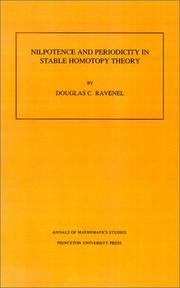
ISBN: 069108792X 069102572X 1400882486 9780691025728 9780691087924 Year: 2016 Volume: 128 Publisher: Princeton, NJ : Princeton University Press,
Abstract | Keywords | Export | Availability | Bookmark
 Loading...
Loading...Choose an application
- Reference Manager
- EndNote
- RefWorks (Direct export to RefWorks)
Nilpotence and Periodicity in Stable Homotopy Theory describes some major advances made in algebraic topology in recent years, centering on the nilpotence and periodicity theorems, which were conjectured by the author in 1977 and proved by Devinatz, Hopkins, and Smith in 1985. During the last ten years a number of significant advances have been made in homotopy theory, and this book fills a real need for an up-to-date text on that topic. Ravenel's first few chapters are written with a general mathematical audience in mind. They survey both the ideas that lead up to the theorems and their applications to homotopy theory. The book begins with some elementary concepts of homotopy theory that are needed to state the problem. This includes such notions as homotopy, homotopy equivalence, CW-complex, and suspension. Next the machinery of complex cobordism, Morava K-theory, and formal group laws in characteristic p are introduced. The latter portion of the book provides specialists with a coherent and rigorous account of the proofs. It includes hitherto unpublished material on the smash product and chromatic convergence theorems and on modular representations of the symmetric group.
Homotopie --- Homotopy theory --- Homotopy theory. --- Deformations, Continuous --- Topology --- Abelian category. --- Abelian group. --- Adams spectral sequence. --- Additive category. --- Affine space. --- Algebra homomorphism. --- Algebraic closure. --- Algebraic structure. --- Algebraic topology (object). --- Algebraic topology. --- Algebraic variety. --- Algebraically closed field. --- Atiyah–Hirzebruch spectral sequence. --- Automorphism. --- Boolean algebra (structure). --- CW complex. --- Canonical map. --- Cantor set. --- Category of topological spaces. --- Category theory. --- Classification theorem. --- Classifying space. --- Cohomology operation. --- Cohomology. --- Cokernel. --- Commutative algebra. --- Commutative ring. --- Complex projective space. --- Complex vector bundle. --- Computation. --- Conjecture. --- Conjugacy class. --- Continuous function. --- Contractible space. --- Coproduct. --- Differentiable manifold. --- Disjoint union. --- Division algebra. --- Equation. --- Explicit formulae (L-function). --- Functor. --- G-module. --- Groupoid. --- Homology (mathematics). --- Homomorphism. --- Homotopy category. --- Homotopy group. --- Homotopy. --- Hopf algebra. --- Hurewicz theorem. --- Inclusion map. --- Infinite product. --- Integer. --- Inverse limit. --- Irreducible representation. --- Isomorphism class. --- K-theory. --- Loop space. --- Mapping cone (homological algebra). --- Mathematical induction. --- Modular representation theory. --- Module (mathematics). --- Monomorphism. --- Moore space. --- Morava K-theory. --- Morphism. --- N-sphere. --- Noetherian ring. --- Noetherian. --- Noncommutative ring. --- Number theory. --- P-adic number. --- Piecewise linear manifold. --- Polynomial ring. --- Polynomial. --- Power series. --- Prime number. --- Principal ideal domain. --- Profinite group. --- Reduced homology. --- Ring (mathematics). --- Ring homomorphism. --- Ring spectrum. --- Simplicial complex. --- Simply connected space. --- Smash product. --- Special case. --- Spectral sequence. --- Steenrod algebra. --- Sub"ient. --- Subalgebra. --- Subcategory. --- Subring. --- Symmetric group. --- Tensor product. --- Theorem. --- Topological space. --- Topology. --- Vector bundle. --- Zariski topology.
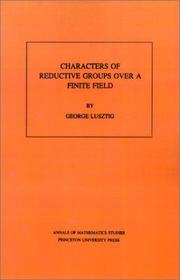
ISBN: 0691083509 0691083517 1400881773 9780691083513 9780691083506 Year: 2016 Volume: 107 Publisher: Princeton, NJ : Princeton University Press,
Abstract | Keywords | Export | Availability | Bookmark
 Loading...
Loading...Choose an application
- Reference Manager
- EndNote
- RefWorks (Direct export to RefWorks)
This book presents a classification of all (complex)irreducible representations of a reductive group withconnected centre, over a finite field. To achieve this,the author uses etale intersection cohomology, anddetailed information on representations of Weylgroups.
512 --- Characters of groups --- Finite fields (Algebra) --- Finite groups --- Groups, Finite --- Group theory --- Modules (Algebra) --- Modular fields (Algebra) --- Algebra, Abstract --- Algebraic fields --- Galois theory --- Characters, Group --- Group characters --- Groups, Characters of --- Representations of groups --- Rings (Algebra) --- Algebra --- 512 Algebra --- Finite groups. --- Characters of groups. --- Addition. --- Algebra representation. --- Algebraic closure. --- Algebraic group. --- Algebraic variety. --- Algebraically closed field. --- Bijection. --- Borel subgroup. --- Cartan subalgebra. --- Character table. --- Character theory. --- Characteristic function (probability theory). --- Characteristic polynomial. --- Class function (algebra). --- Classical group. --- Coefficient. --- Cohomology with compact support. --- Cohomology. --- Combination. --- Complex number. --- Computation. --- Conjugacy class. --- Connected component (graph theory). --- Coxeter group. --- Cyclic group. --- Cyclotomic polynomial. --- David Kazhdan. --- Dense set. --- Derived category. --- Diagram (category theory). --- Dimension. --- Direct sum. --- Disjoint sets. --- Disjoint union. --- E6 (mathematics). --- Eigenvalues and eigenvectors. --- Endomorphism. --- Equivalence class. --- Equivalence relation. --- Existential quantification. --- Explicit formula. --- Explicit formulae (L-function). --- Fiber bundle. --- Finite field. --- Finite group. --- Fourier transform. --- Green's function. --- Group (mathematics). --- Group action. --- Group representation. --- Harish-Chandra. --- Hecke algebra. --- Identity element. --- Integer. --- Irreducible representation. --- Isomorphism class. --- Jordan decomposition. --- Line bundle. --- Linear combination. --- Local system. --- Mathematical induction. --- Maximal torus. --- Module (mathematics). --- Monodromy. --- Morphism. --- Orthonormal basis. --- P-adic number. --- Parametrization. --- Parity (mathematics). --- Partially ordered set. --- Perverse sheaf. --- Pointwise. --- Polynomial. --- Quantity. --- Rational point. --- Reductive group. --- Ree group. --- Schubert variety. --- Scientific notation. --- Semisimple Lie algebra. --- Sheaf (mathematics). --- Simple group. --- Simple module. --- Special case. --- Standard basis. --- Subset. --- Subtraction. --- Summation. --- Surjective function. --- Symmetric group. --- Tensor product. --- Theorem. --- Two-dimensional space. --- Unipotent representation. --- Vector bundle. --- Vector space. --- Verma module. --- Weil conjecture. --- Weyl group. --- Zariski topology.
| Listing 1 - 10 of 28 | << page >> |
Sort by
|

 Search
Search Feedback
Feedback About
About Help
Help News
News